
Great Old Photo on the Matsonford Bridge
April 22, 2021
Conshorockin’s Own Alice Cooper.. Michael Kelly!
April 28, 2021History of a House – 410 Spring Mill Avenue
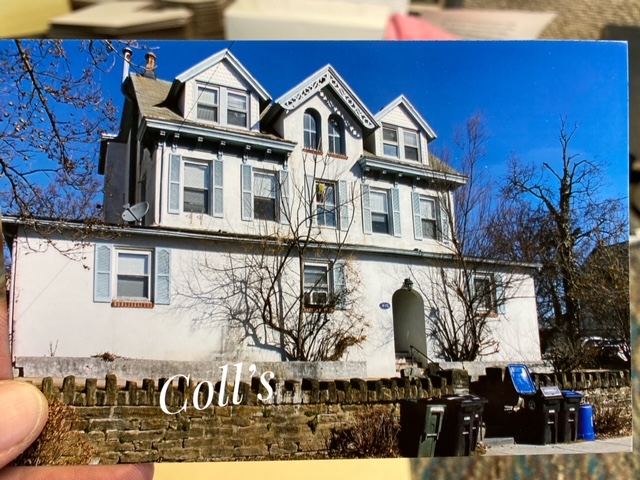
History of a House
410 SPRING MILL AVENUE
Evan D. Jones
What A Story
History Runs A Little Deep With This One!
IT WAS CONSHOHOCKENS FIRST APARTMENT HOUSE
By Jack Coll
4-5-21
Editor’s Note: (This is one in a series of short articles on random houses throughout the borough of Conshohocken, enjoy)
Houses up-and-down the avenues and streets of Conshohocken are, well, today, just houses, but back in the early part of last century, say a hundred years ago many of these houses provided needed services to the community. Many of them were corner stores or mid-block stores, the living rooms of some of these houses doubled as pool rooms, barber shops, cigar stores, candy stores and doctors’ offices. Many of these houses were once home to prominent Conshohocken citizens a generation or two ago. I thought it might be fun, and interesting to point out of few of these houses, that today are occupied by residents who I’m sure had no idea that their house was at one time something more than just a house.

There’s a beautiful free standing Victorian Italianate two and a half story stucco house located at 410 Spring Mill Avenue. The house was built in 1865 as a home for Evan D. Jones and his wife Anna, daughter of William Potts, together the couple had three children William, Martha and Lillian. The building currently serves as an apartment complex. When constructed 410 Spring Mill Avenue had a commanding view of the Schuylkill River overlooking the Schuylkill Iron Works among other industries.
Evan Davis Jones was the son of Jonathan Jones and was born in 1828 on his grandfather Davis farm on Whiskey Land Road (Colwell Lane) just outside the Conshohocken Borough limits. In 1855 the firm of Jonathan Jones & Sons was formed to carry on the lumber business. The firm consisted of Jonathan Jones and his sons Evan D. and Ellwood. In 1875 the firm of Evan D. Jones & Company was organized, Evan being the senior partner.
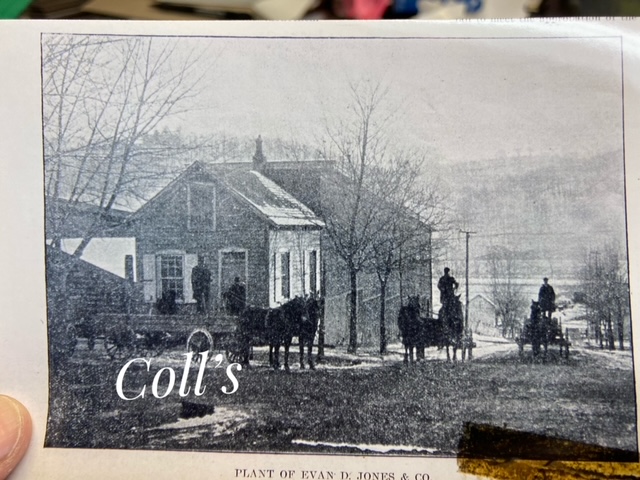
Evan D. Jones and Company were dealers in lumber, plaster, hair cement and fertilizers. Jones’s Lumber Company was located on Hector Street and consisted of more than three acres bounded by Hector, Elm, Cherry and Apple Streets with his office at the corner of Hector and Cherry Streets.
At that time Jones supplied a large amount of building material to his next door neighbor Francis H. Lubbe, who lived at 422 Spring Mill Avenue and at that time was one of the borough’s premier building contractors. It’s likely that most of Conshohocken’s homes and commercial buildings built between 1855 and the 1920’s were with materials from Jones’s Hector Street lumber yard.
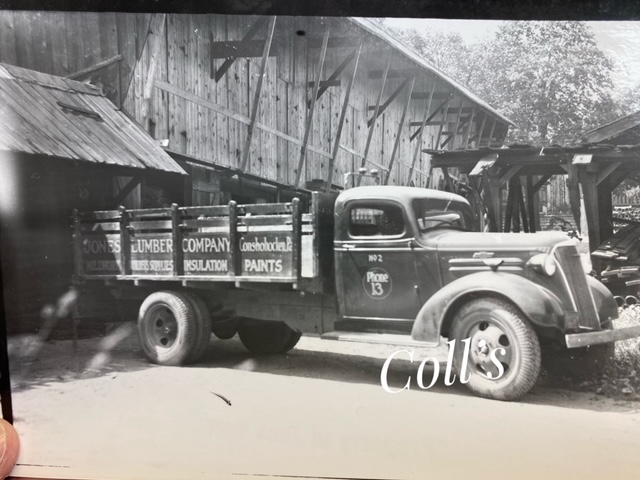
Evan D. Jones passed away in 1889 and covered a lot of ground in his 61 years on this earth. He was a private in the 17th Pennsylvania Calvary for two years and ten months during the Civil War, having achieved the rank of Sergeant, he also served an additional two weeks in the 11th Pennsylvania Militia during the invasion of Pennsylvania.
Jones was one of the most prominent residents during the early history of the borough. In 1873 Conshohocken’s first bank, “The First National Bank of Conshohocken” was granted a charter and opened up for business at the corner of West Hector and Fayette Streets in the former home of George Washington Jacoby. Evan D. Jones, along with Alan Wood Jr., Michael O’Brien, George Bullock, Samuel Fulton and a number of others served as Bank Directors, Evan D. Jones would later serve as President of the Board of Directors and served as a Director until his death in 1889.
Jones served on Conshohocken Borough Council for ten years while serving as Burgess, (Mayor) in 1866.He was active on the School Board and for a couple of years served as Commander of the George Smith Post, NO 79, Grand Army of the Republic and was a high ranking Mason as a member of Fritz Lodge No. 420.
Mr. Jones was a public spirited citizen and had assisted to develop the town. He had used his money and ability in starting and assisting the various industries of the town. He was one of the prime movers in establishing the S. & J. Lees Cotton works as well as the Whitton Mill, he was one member of the syndicate formed to purchase the gas works from T. S. C. Lowe and was largely instrumental in putting that company on its feet, and served as its president until 1889. Jones was one of the original stockholders of the Water Company and was a Director from its organization until his death.
So I think we can all agree that Evan Davis Jones who made his home at was 410 Spring Mill Avenue was one of the early movers and shakers as the borough was being developed. Now comes the second part of 410 Spring Mill Avenue.
410 Spring Mill Avenue became the borough’s very first apartment house, and here’s the story on that, I’ll take a segment out of the book “Tales of Conshohocken & Beyond” written by Jack and Brian Coll several years ago.
As the turn of last century arrived, Conshohocken industry was exploding along the riverfront, immigrants were pouring into the borough at a rapid pace. Industries kept expanding, more jobs were made available and before long there were more jobs in town then there were people who could work the jobs. Relatives of the of the immigrants who had settled in Conshohocken were encouraged to move across the ocean and settle in Conshohocken as the American Dream awaited, get a job, buy a house and raise a family.
By 1902 as the immigrants poured into Conshohocken the borough found itself with a severe shortage of houses, there was nowhere to house the influx of immigrants. And so it started, getting a job was easy, typically with-in two or three days after arriving they were working full time jobs at one of the many plants and mills, but that led to two problems, one was saving enough money to purchase a house and second there were no houses available to purchase. At that time Conshohocken was nearly totally undeveloped from Fourth Avenue on up, it was mostly undeveloped woods and unopened roads and a few farms.
When a house did go up for sale rarely was it made public as private deals for the sale of the house were conducted. In 1902 the Conshohocken Recorder Newspaper stated that, “There are no vacant houses in Conshohocken and small prospect of there being any in the near future.” The paper reported small tent cities popping up in the back yards of residents who either rented their yard allowing immigrants to pitch tents until something became available, or many tents were pitched in relatives yards until the housing market in Conshohocken could expand. All parties shared the backyard outhouses as every yard was equipped with an outhouse.
By 1908 the housing shortage became a discussion for borough council at most meetings. Pressure was put on council to allow the formation of Tent-Cities on the open fields throughout the upper portion of the undeveloped borough until more houses could be built.
During that same year the Alan Wood Steel Company and the Lee Surgical Supply Company announced expansions of their operations. Lee had more than 1500 employees at his East Eighth Avenue surgical supply plant and had recently purchased several Philadelphia operations and planned to remove them to Conshohocken. At that time the Alan Wood Company had 3,000 employees along the river and keep in mind that by 1915 the company had nearly 5,000 employees.
The Recorder newspaper stated that bringing all these new people to our borough to work, “places this borough in a very embarrassing and unenviable position, where are we going to house these newcomers.” Keep in mind that labors back in 1908 didn’t drive automobiles, employees didn’t drive from New Jersey or Delaware to go to work back then, employees walked to work, and therefore lived where they worked. The Recorder also stated that because of a lack of housing for the workers that Conshohocken had lost several industries to Norristown as the Norristown community had been very helpful in finding and building houses for the workers.
In an effort to help ease the housing crises Alan Wood Steel Company purchased large tracts of land in Swedeland and in Connaughtown, John Elwood Lee would later purchase a large tract of land along East Twelfth Avenue and constructed houses for their employees, the employees would have the mortgage or rent money taken out of their pay. The Wood Company also built company houses along East Third Avenue.
The housing crises started in 1902 when believe it or not the steel mills caused the shortage in two ways, first expansion of the mills requiring more than a thousand employees. These workers lived throughout the area not only in Conshohocken but in West Conshohocken, Swedeland, Bridgeport, Swedesburg, Norristown, Plymouth, Lower Merion, Gulph Mills and in the out stretched areas.
Second, the expansion of the Steel Mills in 1902 were multi-million dollar expansions resulting in a brick shortage. The steel mills purchased millions of bricks to construct large buildings and line furnaces resulting in a shortage of bricks. The shortage of bricks and materials for local brick companies meant that the brick company once located on West Sixth Avenue run by Frank O’Brien forced their prices to jump from $4.00 per thousand bricks to $6.25 per thousand bricks and the possibility of not meeting the demand to complete the building of a house causing a building freeze for local contractors.
In time the brick shortage ended and prices returned to $4.00 per thousand and from 1912-1922, the largest building boom in the borough occurred. Within a decade many new developments popped up in an effort to relive the housing crises.
All of this background brings us back to 410 Spring Mill Avenue. During this housing shortage the Conshohocken Recorder Newspaper ran an editorial raising the question about apartments, or as they were called back then, “Flats.” In 1908 Conshohocken had NO apartments, no apartment buildings, and no large houses converted to apartments. The editorial encouraged developers to seriously consider building apartments as they have been successful in other towns. A number of the working class immigrants who arrived in Conshohocken complained they couldn’t rent an apartment.
We should keep in mind that at that time outhouses were still very much in use, and could still be found in many backyards of houses on the avenues as late as 1950. Running water to each and every apartment would be a problem not to mention baths. Most of the big old iron tubs we remember from the day had rubber hoses connected to the drain and when you pulled the plug the water would run into the backyard or to the curb in front of your house.
So with all that in mind, in October of 1919, Lillian Jones, daughter of Evan D. Jones lived in her parent’s house at 410 Spring Mill Avenue. Lillian was tired of living alone so she started construction to convert her very spacious house into three modern apartments plus her living quarters. Work started in late 1919 and in early 1920, Lillian was renting her apartments receiving some very high praise for her efforts, it was noted that this was Conshohocken’s very first apartment house.
In the spring of 1924 a fire was reported at 410 Spring Mill Avenue in Lillian’s apartment as the result of a wood fire to take the spring chill out of the room. Both fire companies including the Washington Fire Company and Conshohocken Fire Company No. 2 responded and noted that several pieces of furniture were on fire among parts of two rooms. The firemen were able to gain control of the blaze with very little damage.
Lillian passed away five years after the fire in November of 1929. Lillian was born and died as a resident of Conshohocken, she never married or had children and died at the age of 61, the same age as her father when he passed.
So now ya know, Conshohocken’s very first apartment building opened for business one hundred and one years ago. Today some estimates put apartments and rental properties at nearly 40 percent in Conshohocken.
Housing isn’t as urgent today as it was a century ago, you know people driving and taking trains. People who live in New Jersey or Delaware drive to Conshohocken five days a week for their job and residents of Conshohocken drive to New Jersey and Delaware to earn their living.
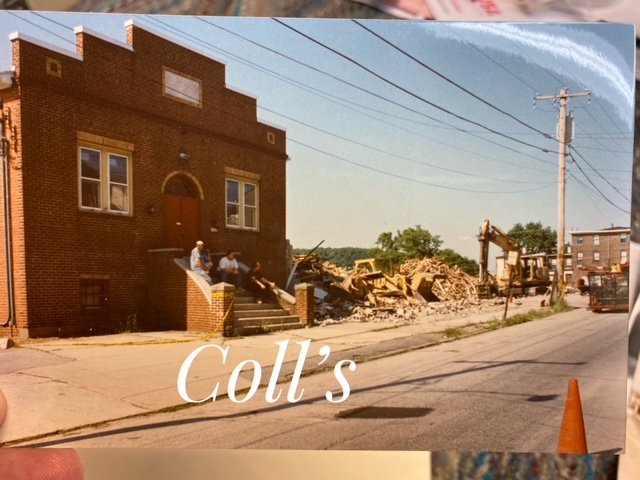
Evan Jones’s Lumber Yard years later became S. Marchak Lumber Company at Hector and Cherry Streets. The west wall collapsed along Cherry Street in 1983, the yard closed sometime in the 1990’s, and the yard and office building were demolished in 1996. Town houses now occupy the site.


For more episodes of History of a House go to Conshystuff.com and look for articles by Jack Coll. Log onto Conshystuff.com face book to keep up with all the latest happenings in and around the borough.
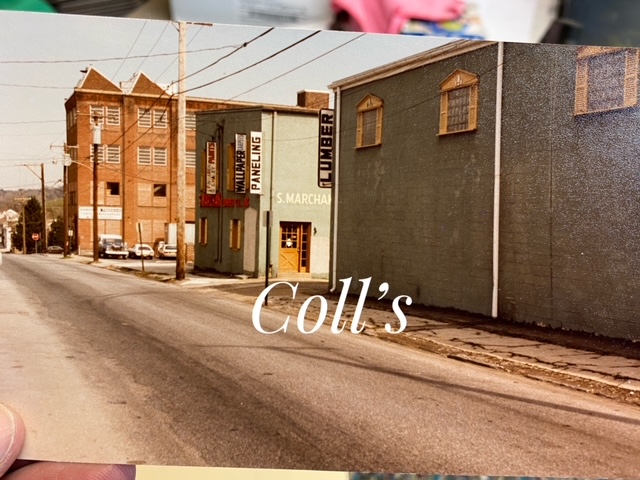
If you were wondering what that sight looks like today:

Photographs Above Include:
410 Spring Mill Avenue, former home of Evan Jones and later his daughter Lillian Jones.
A photograph taken before the turn of last century showing Evan Jones Business Office at the corner of Hector and Cherry Streets. Employees of the Jones Lumber Company are posed with their horses and lumber delivery wagons.
A delivery truck at the Jones Lumber Company once located on West Hector Street is seen more than 70 years ago is loaded with lumber preparing for its next delivery.
S. Marchak Lumber Company on Hector Street in the early 1990’s.
The collapse of the west wall along Cherry Street in 1983.
Photos of the demolition of Marchak’s in 1996.

